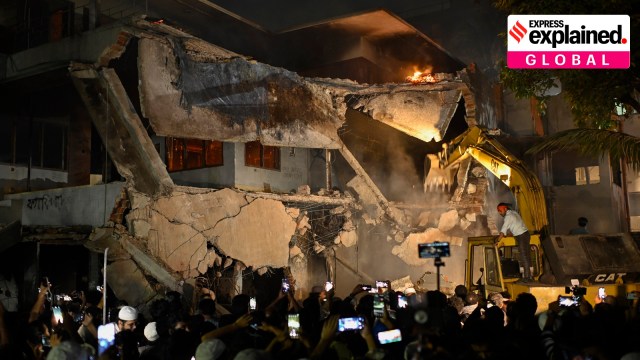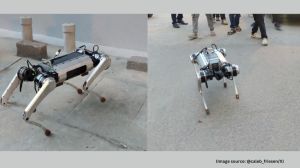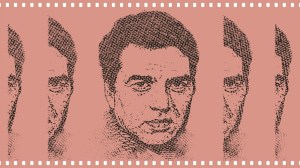The story of Dhanmondi 32, Mujibur Rahman’s home now reduced to ruins in Dhaka
Mujibur Rahman’s Home Demolition: Attack on Bangladesh’s iconic national monument reflects anger at Sheikh Hasina’s Awami League, a different vision of the country’s struggle for liberation. Here’s how Bangabandhu built his home into the heart of the nationalist struggle against the brutal Pakistani regime
 Protesters use heavy machinery to demolish the residence of Sheikh Mujibur Rahman, Bangladesh's former leader and father of the country's ousted Prime Minister Sheikh Hasina, at Dhanmondi in Dhaka, Bangladesh, Thursday, Feb. 6, 2025. (Photo: AP)
Protesters use heavy machinery to demolish the residence of Sheikh Mujibur Rahman, Bangladesh's former leader and father of the country's ousted Prime Minister Sheikh Hasina, at Dhanmondi in Dhaka, Bangladesh, Thursday, Feb. 6, 2025. (Photo: AP)Bangabandhu Memorial Museum Demolition Explained: A large portion of Dhanmondi 32, the iconic building in Dhaka in which Bangabandhu Sheikh Mujibur Rahman, the founding father of Bangladesh, lived and died, has been demolished.
Vandals attacked and set fire to the building, which housed the Bangabandhu Memorial Museum, on Wednesday (February 5) evening, and began demolishing parts of it with hammers and shovels. Later, an excavator and crane were pressed into service to tear the building down.
The attackers stopped briefly later in the night, but returned at dawn on Thursday with demolition equipment and continued to tear down the structure, Bangladeshi media reported. Pictures showed the building in ruins, with hundreds swarming over the rubble, and the words “thakbe na (will not remain)” scrawled on a wall by hand in large letters.
Other buildings and structures linked to the life and followers of the founding father of Bangladesh were also targeted overnight. Reports in Prothom Alo, The Daily Star, and Dhaka Tribune said Sudha Sadan, the residence of former Prime Minister Sheikh Hasina, had been set on fire, and a bulldozer had been used to smash a mural of the Bangabandhu in front of the deputy commissioner’s office in Sylhet.
In Khulna, “Sheikh Bari”, which belongs to five cousins of Hasina, was pulled down, and in Barisal, bulldozers were used to raze the homes of two senior leaders of Hasina’s Awami League.
The home that Mujib built, where he was killed
Mujib moved into the premises that would become Dhanmondi 32 in August 1961, and started living in a small, two-room home he had built there. These premises were expanded over time – and they would be his home until August 15, 1975, when a group of military officers murdered him there, along with most members of his family.
Among those killed was Sheikh Russell, Mujib’s 10-year-old son, who was born in the same house in 1964. The only members of the family who escaped the massacre were Mujib’s daughters Sheikh Hasina, the future Prime Minister, and Sheikh Rehana, who were in Europe at the time.
Heart of the Bangladesh Liberation Movement
Mujib spent most of the last decade and a half of his life in this house, whenever he was not in prison.
This was his headquarters as he led the movement against Pakistan’s then ruler Gen Ayub Khan in 1962, and he was living here when the famous Six-Point Proposal of the Awami League, demanding autonomy for East Pakistan, was made. The proposals were presented to a committee set up by the Pakistani government in Lahore on February 5, 1966. They were rejected, and Mujib was branded a separatist.
In the 1970 general election for Pakistan’s National Assembly, Mujib’s Awami League swept East Pakistan, winning 160 of the 162 general seats in the province, a clear majority of the 300 general seats in Parliament. President Yahya Khan refused to notify the National Assembly, and subsequent events led to the Non-Cooperation Movement, the brutal Pakistani crackdown in the East, and finally the Liberation Struggle and the birth of Bangladesh.
Through this entire period, the Dhanmondi house was Mujib’s home and base. According to the website of the Bangabandhu Memorial Museum, “the house was the center of all of Bangabandhu’s political activities, including planning activities, exchanging views with leaders and activists, and listening to the grievances of the people”.
It is at the conference table of this house that he prepared the framework of the historic March 7, 1971 speech at Dhaka’s Ramna Race Course to more than a million people, which is seen as the informal declaration of independence from Pakistan.
“In the upstream days of 1971, local and foreign journalists had rushed to this house,” says the Museum website. “After the Liberation War, when Bangabandhu served as the president of an independent Bangladesh, he used his home as a base of operations to make decisions on running the government,” it says.
From Mujib’s home to a museum to his memory
Dhanmondi 32 was turned into a museum on August 14, 1994 at the initiative of the Bangabandhu Memorial Trust.
Upon her return to Bangladesh from India in 1981, Hasina visited her childhood home, and was soon served an auction notice from the House Building Finance Cooperation of Bangladesh. According to the museum website, a sum of 12,000 taka was demanded from her, which she paid to save the house from being auctioned. She subsequently handed over the premises to the Bangabandhu Memorial Trust, and Mujib’s home became the Bangabandhu Sheikh Mujibur Rahman Memorial Museum.
- 01
- 02
- 03
- 04
- 05






































